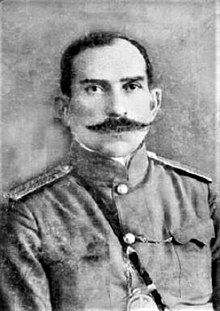Giorgi Ivanovich Masniashvili
Giorgi Ivanovich Masniaschwili ( Georgian : გიორგი ივანესძე მაზნიაშვილი; Russian : Георгий Иванович Мазниашвили * 6. April 1870 in the village Sasireti , Kaspi Municipality , Governorate Tbilisi , Russian Empire ; † 16th December 1937 ) was a Georgian General, Lieutenant Colonel of the Imperial Russian Army and one of the most prominent military figures of the Democratic Republic of Georgia (1918–1921).
biography
Masniashvili received his military training in Russia . He took part in the Russo-Japanese War and was distinguished by steadfastness. Here he sustained serious injuries and was taken to a hospital , where the daughters of the last Russian emperor Nicholas II looked after him. There Nicholas II paid him a visit and personally presented Masniashvili with the Order of St. George .
During the First World War Masniashvili fought on the Western Front and was wounded near Warsaw . After the February Revolution of 1917 , he returned to Georgia and organized the 2nd Georgian Division to protect Tbilisi from the chaotic retreat of the disbanded tsarist units.
On the basis of the peace treaty of Brest-Litovsk in April 1918, Ottoman troops occupied the city of Batumi , from where they continued their advance eastwards into the interior of Georgia until the units of Masniashvili repulsed them on the Choloki River near the Osurgeti province .
In June 1918 Masniashvili was appointed Governor General of Abkhazia . Here he participated in the suppression of the Bolshevik resistance. In the same month he commanded two Georgian batteries consisting of a total of 500 soldiers in the so-called Sochi conflict against the army of White General Anton Denikin , the commander of the armed forces of southern Russia.
In October 1918 Masniashvili was appointed governor general of the Tbilisi district. Just a month later he became commander in chief of Georgian troops in the war against Armenia . His units successfully defended themselves against the advancing army of Drastamat Kanajan (General Dro) in southern Georgia. 1919 Masniaschwili were the provinces of Akhaltsikhe and Akhalkalaki entrusted to manage. In October 1920 he was promoted to garrison chief in Tbilisi a few months before the Democratic Republic of Georgia (DRG) was dissolved by the Soviets .
After the establishment of Soviet power in Georgia, Masniashvili served as a division commander in the Red Army from April 1921 and a few months later as the infantry inspector.
In 1923 Masniashvili was sentenced to death by shooting together with the members of the so-called "War Center", which consisted of the former military members of the DRG, for allegedly organizing the anti-Soviet uprising. But two years later he was released from death row and then emigrated to Iran . From there he went into exile in France and lived in Paris for a few years . After long negotiations with Soviet officials, Masniashvili was finally allowed to return to Georgia. However, the last years of his life were marked by poverty, injustice and reprisals. He was denied a work permit and a pension. In the end he moved to his native Sasireti and lived mainly from agriculture.
At the zenith of the Stalinist purges , Masniashvili was arrested with his son in 1937 and shot without trial. The whereabouts of his grave are still unknown today.
Individual evidence
- ↑ Новые памятники и мемориалы в Грузии. Retrieved September 16, 2018 (ru-RU).
- ↑ Георги И. Мазниашвили: Воспоминания. 1917-1925 . Тбилиси 1927.
- ↑ Президент Грузии отметил Гиоргоба на родине легендарного генерала Мазниашвили. Retrieved September 16, 2018 .
| personal data | |
|---|---|
| SURNAME | Masniashvili, Giorgi Ivanovich |
| ALTERNATIVE NAMES | მაზნიაშვილი, გიორგი ივანესძე (Georgian); Мазниашви́ли, Гео́ргий Иванович (Russian) |
| BRIEF DESCRIPTION | Georgian General, Lieutenant Colonel of the Imperial Russian Army |
| DATE OF BIRTH | April 6, 1870 |
| PLACE OF BIRTH | Sasireti , Kaspi Municipality , Tbilisi Governorate , Russian Empire |
| DATE OF DEATH | December 16, 1937 |
